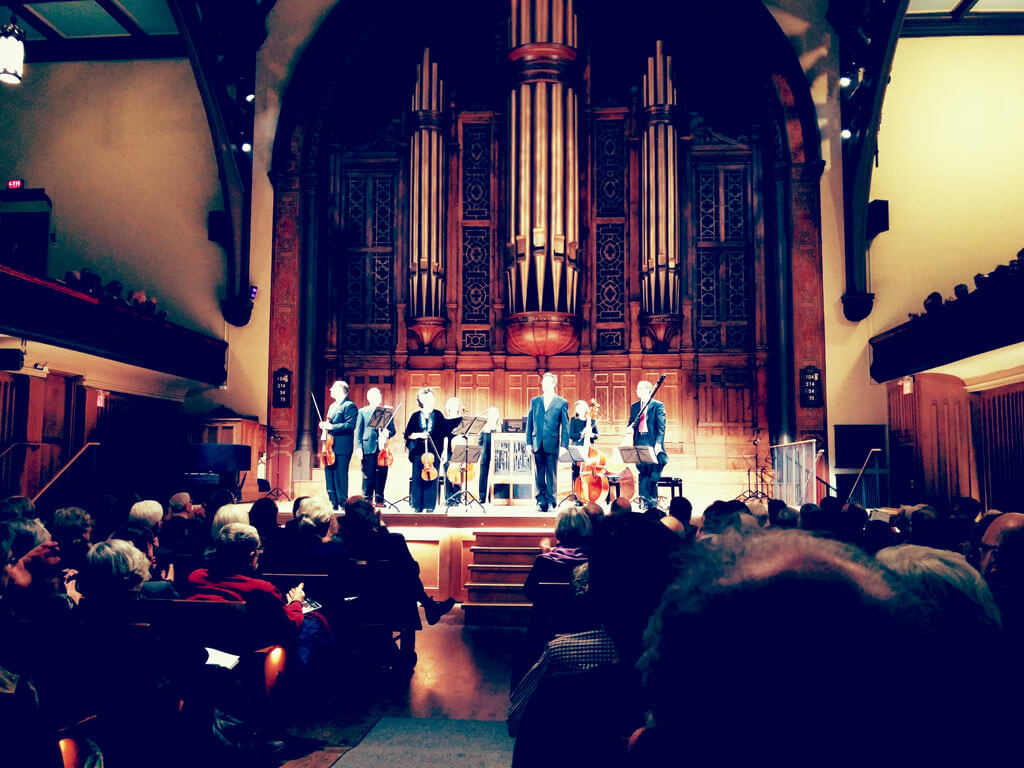
Tafelmusik Orchestra, directed by Jeanne Lamon. With soloist, baritone Peter Harvey. January 19. Trinity-St Paul’s Centre. Repeats to January 22.
It’s fascinating how Tafelmusik frequently turns to intimate concerts in the dead of winter. It’s like they’re pulling the circle tighter, drawing us closer to the snap and crackle of whatever musical firewood they have thrown in the hearth. This particular January may feel more like March, but the flames happily took in the Germanic hardwood on offer Thursday night at Trinity-St Paul’s Centre.
The music of Johann Sebastian Bach is the core of this week’s program, cleverly set within its roots and context by former music director Jeanne Lamon. Many of the works had not been heard from this period-performance orchestra before. Each made a strong case for itself – but the one big, known masterwork on the program did not have to worry about being knocked off its pedestal.
Lamon was back on stage, too, violin in hand. Her small band of fellows included Tafelmusik’s finest, including violinist Julia Wedman, oboe player John Abberger and Dominic Teresi, wielding the dulcian, the bassoon’s Baroque-era ancestor. Joining them was British baritone Peter Harvey the late-17th-century program, which included instrumental-only pieces alongside two cantatas and a lament.
The evening opened with a virtuoso display of violin playing in a sonata by Heinrich Biber (1644-1704). This predecessor of J.S. Bach’s has never fully broken into listeners’ Baroque-era A-list, but his music is so rich in invention, complex counterpoint and sheer beauty that he deserves far greater recognition as a 17th-century master.
Biber returned with a violin sonata later in the evening, a spectacular work spectacularly played by Wedman, with a trio of continuo players as backup. Wedman’s command of her bow is awe-inspiring, teasing incredible subtleties out of the tiniest of gestures in a piece that veers wildly between virtuosic blowouts and affecting contemplation. The Chaconne movement, built on a mere four-note foundation, is a gem.
Harvey’s first appearance on stage came in a cantata, Mein Herz ist Bereit, by Dietrich Buxtehude (1637-1707), one of J.S. Bach’s greatest influences (the composer is said to have walked 400 kilometres when he was a young organist to hear his idol perform). I find Buxtehude’s music to be quite mechanical most of the time. Buxtehude, who was born in Denmark, did not have a strong sense of whimsy. Like Danish Lego blocks being assembled, the setting of the text dutifully interspersed verse with instrumental interludes.
Alsatian bassoonist and composer Phillip Friedrich Böddekker (1632-1683) supplied a sonata based on a popular tune of the day that allowed Teresi to show off his skills with a double-reed instrument, ably backed by Wedman and the continuo players.
Harvey was present for two more vocal works on the program: J.S. Bach’s much-loved Ich Habe Genug (Cantata 82) — the evening’s only piece of music written after 1700 — and a lament written by his older cousin, Johann Christoph Bach (1642-1703). The elder Bach’s setting of a plea to God was a revelation, with its clever use of solo violin (played by Lamon) to serve as a sort of barometer for the soul’s state during the singing of the words.
Harvey is a pleasure to listen to. He may be a lyric baritone, ideally suited to Baroque-era music and art song, but he also has a nice, full chest voice. He is a fine craftsman, shaping phrases with great skill, and subtly shading each note.
As I mentioned earlier, J.S. Bach’s cantata had little to worry about. Hearing it set alongside the other works on the programme, all predecessors of his composition, was a reminder of how masterful Bach could be at conveying very personal, touching emotion in his music — and how he uses repetition to establish a mood, make the listener familiar, and then feel intense comfort at the return of the familiar.
Well sung and ably accompanied, this was a sure way to end the evening with a contented smile. The Bach cantata is worth the price of admission alone, and Julia Wedman’s pulse-quickening, soul-stirring interpretation of the Biber sonata was icing on the cake.
For more REVIEWS, click HERE.
#LUDWIGVAN
- Classical Music 101: What Does A Conductor Do? - June 17, 2019
- Classical Music 101 | What Does Period Instrument Mean? - May 6, 2019
- CLASSICAL MUSIC 101 | What Does It Mean To Be In Tune? - April 23, 2019



